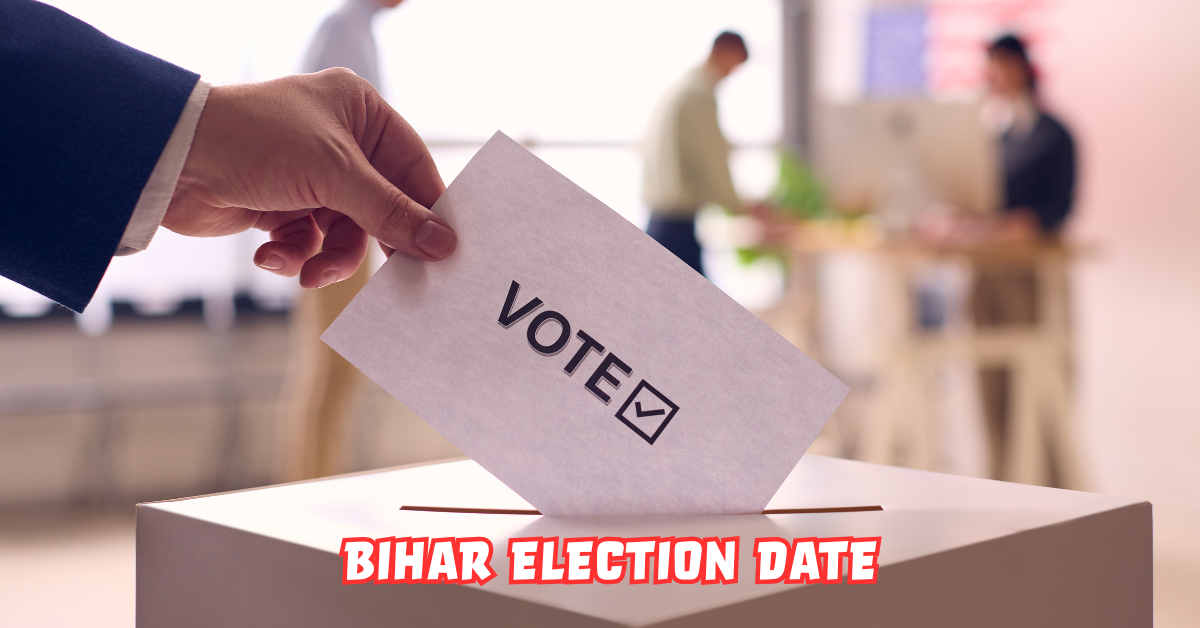Bihar is one of India’s most politically dynamic states, a site where caste, development, identity, and shifting alliances converge. The legislative term of the current Bihar Assembly expires on November 22, 2025, which means the election must be held before that date. The Indian Express+2mint+2
In past cycles, elections in Bihar have spanned multiple phases to balance logistical challenges and security demands. In 2020, polls were held on October 28, November 3, and November 7 — a three-phase arrangement. Wikipedia
Given the lessons from the past, the Election Commission this year faced the challenge of honoring festival schedules (Diwali, Chhath), avoiding overlaps, mitigating disruptions, and yet ensuring smooth polling in a populous, diverse, and large state. www.ndtv.com+3www.ndtv.com+3mint+3
A senior Election Commission official observed, “Everything has pros and cons, and we will look into it,” when asked about how many phases the poll would take. mint
Thus, the final decision — two phases, November 6 and November 11 — reflects a balancing act between administrative feasibility and political pressures.
The Official Dates: What Has Been Announced
Below is a snapshot of the official election schedule as declared for 2025:
| Stage | Date | Description / Notes |
|---|---|---|
| Phase 1 Polling | November 6, 2025 | First phase of voting across designated constituencies |
| Phase 2 Polling | November 11, 2025 | Second and final phase of polling |
| Vote Counting | November 14, 2025 | Counting and announcement of results |
These dates are now confirmed by major Indian media outlets, such as Times of India and Economic Times. The Times of India+2The Economic Times+2
Some earlier reports had entertained the possibility of three phases (November 5–15) or scheduling after Chhath, but the two-phase scheme prevailed. www.ndtv.com+4India Today+4mint+4
Also noteworthy: the ECI has emphasized that all electoral processes (notification, nominations, polling, counting) must be completed before November 22, the constitutional deadline. The Indian Express+1
There is political logic too — in an interview, the Chief Election Commissioner affirmed that the Commission introduced new features (reduced number of voters per booth, improved webcasting) precisely to make polling manageable in fewer phases. News On Air+2mint+2
This is the first time in Bihar’s recent history that a two-phase schedule has been officially declared with such confidence, suggesting confidence in administrative readiness and security arrangements.
3. Why Two Phases? Navigating Festivities, Security, and Voter Convenience
Festival Timing and Electoral Calendar
One of the most cited constraints in deciding Bihar’s election schedule is the timing of two major festivals — Diwali (October 20, 2025) and Chhath Puja (around October 28, 2025). mint+3www.ndtv.com+3www.ndtv.com+3
If polling were scheduled too close to these dates, voter turnout, logistical deployment, and administrative attention could all suffer. Thus, the poll body aimed to bracket those festivals, and the November 6 / 11 plan does exactly that — sufficiently after Chhath, and before the Assembly term ends. News On Air+3www.ndtv.com+3mint+3
Security and Logistical Considerations
With Bihar’s size (243 assembly seats) and diverse geography (rivers, flood plains, remote rural districts, security-sensitive zones), the ECI must deploy central paramilitary forces, configure polling booths, ensure accessibility, and avoid administrative bottlenecks. The Economic Times
In fact, reports indicate that over 1,200 battalions of central forces will be deployed during the polling. The Economic Times
By limiting to two phases, the ECI can concentrate its resources and avoid repeated logistical costs and redeployment complexities. Every extra phase increases transport burdens, polling station transfers, security rotation, and coordination challenges.
Voter Comfort and Turnout
Reducing the number of phases also helps in minimizing voter confusion, reducing election fatigue, and ensuring that polling personnel, observers, and voters can align schedules better. Quotes from political party leaders urged that elections be held “immediately after Chhath” to avoid drag, and even recommended a single-phase model. India Today+2mint+2 But given constraints, the two-phase plan represents a kind of “least worst compromise.”
As one local observer put it, “We don’t want voting in the shadow of a festival; better clean space before voters go to the polling.” This sentiment reflects how cultural rhythms influence electoral timing in India’s states.
The Road to Announcement: Electoral Roll Revision and Preparatory Moves
Special Intensive Revision (SIR) of Voter Rolls
A foundational step before any election is preparing a clean, updated voter list. For Bihar 2025, the Election Commission initiated a Special Intensive Revision (SIR) starting June 25, 2025. mint+1
By July 25, enumeration work was complete, and the draft electoral rolls were published on August 1, with a deadline for claims, objections, and documentation taking place through September 1. mint+1
As of the latest update, over 98.2% of elector documents have been accepted. Press Information Bureau
The final electoral list is slated for publication on September 30, 2025. Moneycontrol+2mint+2
Only after the final list is in place can the Election Commission issue the formal schedule for nominations, scrutiny, polling, and counting. Historically, the EC releases the election timetable within days of final roll publication. The Times of India+3mint+3Moneycontrol+3
Observer Deployment, All-Party Meetings, and Visits
Ahead of the final decision, the EC conducted a two-day visit to Bihar (October 4–5) to assess polling preparedness, meet local officials, and interact with party representatives. mint+3The Times of India+3News On Air+3
On October 3, a meeting with appointed observers took place to align expectations and protocols. The Indian Express+1
At the same time, the EC held “all-party” consultations to listen to concerns from recognized state and national parties, especially about phase structure, booth norms, and festival interference. News On Air+2mint+2
Importantly, the EC also launched 17 new initiatives aimed at improving transparency, accessibility, voter assistance, and technological integration — including better candidate photo display, reduced booth load, and webcasting all polling stations. News On Air+2The Times of India+2
These preparatory actions signal the seriousness to conduct elections not merely on time, but with enhanced efficiency.
Competing Models: Two Phases vs. Three (or More)
From earlier reporting, there was speculation that the EC might go with a three-phase schedule between November 5 and 15. India Today+2www.ndtv.com+2
Some political parties, especially those in the opposition bloc, supported multi-phase polling, hoping to stagger campaigning and avoid concentration of state resources in short windows. mint+1
On the other hand, ruling coalition members and the EC seemed more inclined to fewer phases, citing administrative simplicity and cost management. The NDA reportedly lobbied for a single-phase election, though that demand was not accepted. mint+1
The EC needed to weigh the tradeoffs: more phases = smaller per-phase workload but greater cumulative complexity; fewer phases = higher daily demands but better resource concentration. As the EC put it, “We have listened to parties suggesting how many phases there should be … Everything has pros and cons.” mint
In many ways, the final two-phase decision is a median path — it is ambitious but falls short of being overextended. It also reflects confidence in administrative mechanisms, security apparatus, and the capacity to mobilize polling stations swiftly.
Strategic Implications: What the Date Means for Parties and Voters
Campaign Calendars, Alliances, and Messaging
With the election window set in November, political actors must compress their campaign planning into a tight timeline. Alliance negotiations, candidate selection, manifesto preparation, media blitzes, and ground mobilization must now proceed quickly.
For example, Chirag Paswan’s LJP (Ram Vilas) is pushing for 40 assembly seats, while BJP is reportedly offering 25 — this internal bargaining must now crystallize ahead of nomination deadlines tied to the announced schedule. Indiatimes
Similarly, Prashant Kishor’s Jan Suraaj Party enters the fray, disrupting traditional alignments; with a firm schedule, all players must frame strategies, target constituencies, and deploy resources more decisively.
For the INDIA bloc (opposition) and Mahagathbandhan (RJD + Congress + left parties), the narrowing window means fewer days for last-minute coalition shifts, seat sharing, and messaging calibration.
Voter Mobilization and Festival Dynamics
Given the proximity of Chhath, parties will likely intensify efforts right after the festival, appealing to voters whose attention may be consumed by religious commitments. Many rural voters travel during Chhath, so post-festival outreach becomes critical.
“Elections after Chhath get space, not in festival shadows,” a campaign strategist noted. In effect, November 6 is soon after the festival, giving just days of recovery—but the compressed calendar pushes parties to maximize every moment.
Administrative Pressure and Risk Management
Administrators must now finalize polling booth allocations (targeting 1,200 voters per booth), train tens of thousands of poll workers, deploy security forces, ensure webcasting, and coordinate across diverse terrains (flood zones, border districts, remote areas). The Indian Express+2mint+2
Any failure in this compressed schedule could spark criticism over delays, disenfranchisement, or technical lapses.
Historical Comparisons: Bihar Elections in Past Patterns
Understanding the 2025 schedule is richer when seen against Bihar’s electoral history. Here is a comparative snapshot:
| Year | Phases | Poll Dates | Result Date | Notable Features |
|---|---|---|---|---|
| 2020 | 3 | Oct 28, Nov 3, Nov 7 | Nov 10 | Multiple phases to manage crowding during COVID-era turnout Wikipedia |
| 2015 | 5 | Oct 12, Oct 16, Oct 25, Nov 1, Nov 5 | Nov 8 | Very phased due to security and geographical constraints |
| 2010 | 5 | Oct 21, Oct 24, Oct 28, Nov 1, Nov 6 | Nov 8 | Similar multi-phase structure |
| 2025 (projected) | 2 | Nov 6, Nov 11 | Nov 14 | Leaner schedule, greater administrative confidence |
Across these cycles, two trends stand out: (1) a move over time to fewer phases when possible, and (2) careful adjustments to avoid overlap with festivals and floods. The 2025 schedule marks a continuation of those trends — more ambition, less fragmentation.
Challenges, Concerns, and Controversies
Voter List Disputes & Legal Challenges
The SIR process has drawn criticism from opposition groups, some labeling it as overzealous or exclusionary. The Association for Democratic Reforms (ADR) has even taken the EC to the Supreme Court, alleging that the process diverges from earlier IR norms. The Economic Times
Concerns include: whether some valid voters are left out, whether citizenship proofs are being demanded excessively, and whether double registration is being aggressively purged.
Though the final electoral rolls have been largely accepted, any last-minute legal challenge or court stay could throw parts of the schedule into uncertainty.
Weather, Floods, and Geography
Bihar’s monsoon season, riverine terrain, and flood-prone districts (especially in northern Bihar) often complicate logistical arrangements. Polling in November is late enough to avoid monsoon rains, but unforeseen weather or river swells could still affect remote booths.
Security Incidents and Interference
Deploying central forces (1,200+ battalions) helps, but Bihar has had its share of election-related violence, intimidation, and booth capture attempts in past cycles. The compressed schedule places added strain on security protocols, requiring tight coordination.
Administrative Overstretch
With only two phases, the EC must ensure there is no overburdening of staff, delays in transporting EVMs (electronic voting machines), and no mismanagement in overlapping deadlines. Any glitch in nomination scrutiny, dispatch of polling material, or webcasting infrastructure could have cascading effects.
One senior bureaucrat privately remarked, “We have one shot to get it right — margins for error are thinner now than ever.”
What Voters and Observers Should Watch For
- Publication of final voter list on September 30 will be a critical milestone; any pending objections should be resolved by then.
- Notification of candidate nominations, scrutiny, and withdrawal deadlines will follow soon after the schedule release; parties must stay alert.
- All-party and observer meetings may issue directions on enforcement, campaigning norms, expenditure limits, and complaint redressal.
- Deployment of webcasting, mobile deposit facilities, and other innovations unveiled by EC should be monitored, for they affect transparency and trust. The Economic Times+1
- Security deployment and booth configurations, especially in vulnerable districts, will test administrative preparedness.
- Media coverage, polling trends, and exit polls will take shape quickly in the shorter campaign window — observers should watch narrative shifts.
As one election analyst put it: “In this compact window, momentum matters more — a few good days can swing many seats.”
Why the Date Matters — For Democracy, Development, and Representation
Picking an election date is not merely administrative — it signals political balance, respect for festivals, logistical capacities, and democratic confidence. A well-timed election that gives voters breathing room, ensures security, and offers clarity fosters higher turnout and legitimacy.
For Bihar, a state wrestling with migration, youth unemployment, agrarian distress, infrastructure gaps, and social equity challenges, the outcome of the 2025 election will determine the next governance trajectory for millions.
Anchoring the election in early to mid-November (6 and 11) serves multiple purposes: it respects cultural rhythms, aligns administrative readiness, offers parties time to campaign, and maintains constitutional continuity. Voters now know where and when to cast ballots; the real question is who will win their trust.
FAQs
1. Why was November 6 and 11 chosen instead of earlier dates?
Because major festivals like Diwali and Chhath fall in late October, and the Assembly term ends November 22, the EC opted for early-to-mid November dates that avoid festival conflicts while giving time for final preparations.
2. Could there still be more phases added later?
Unlikely — the schedule has already been officially declared. The EC considered multiple phase scenarios but settled on two as administratively optimal.
3. What if someone is left out of the electoral roll after publication?
There is a window for claims and objections before the final roll. After that, judicial remedies may remain, but last-minute changes are difficult. Hence checking and correcting one’s registration before cutoffs is essential.
4. Will webcasting and mobile deposit help polling transparency?
Yes, these are among the innovations introduced by EC to reduce malpractices and streamline voting-day logistics. They allow real-time surveillance and smoother voter experience.
5. How should political parties adjust their campaign strategy under this schedule?
They must compress planning, prioritize constituencies quickly, manage alliance deals early, and mobilize ground workers aggressively in the narrow window between publication and polling.
Conclusion
The announcement that Bihar’s 2025 Legislative Assembly elections will be held on November 6 and November 11, with counting on November 14, breaks months of uncertainty. This decision reflects a careful calibration between festivals, administrative constraints, security imperatives, and political pressures.
Through Special Intensive Revision of electoral rolls, preparatory observer visits, all-party consultations, and 17 new EC initiatives, authorities have endeavored to ensure that the two-phase model is not just ambitious but feasible. As Bihar’s voters prepare for the most consequential election in a generation, the stakes could not be higher.
With the dates now fixed, every party, candidate, and voter must shift into full gear. The outcome will not merely produce a new government — it will set the course for Bihar’s development, identity politics, and governance for the next half decade.
“Everything has pros and cons … we will look into it,” said the Chief Election Commissioner on the phase decision.
“We don’t want voting in the shadow of a festival,” argued a local campaigner, underscoring the cultural stakes.
As one election analyst mused, “In this compact window, momentum matters more — a few good days can swing many seats.”
In a democracy, timing is more than ceremony — it’s strategy, fairness, and legitimacy. Bihar 2025 now marches toward November, and every voter will have their role to play.











